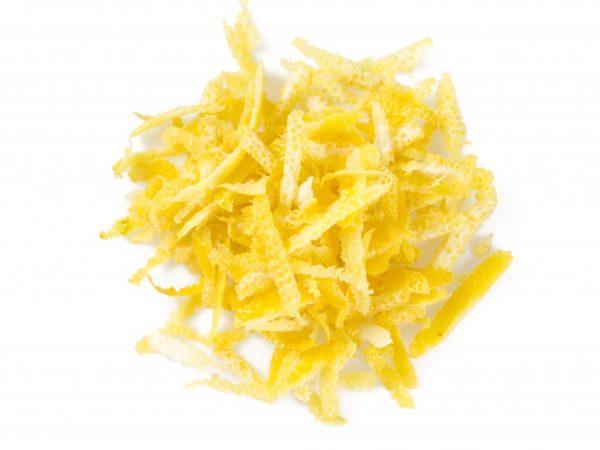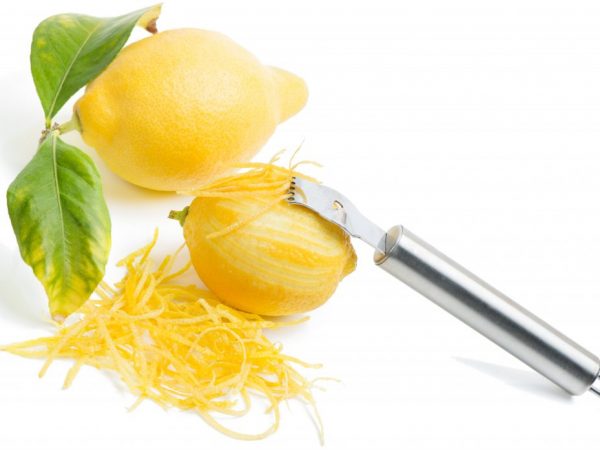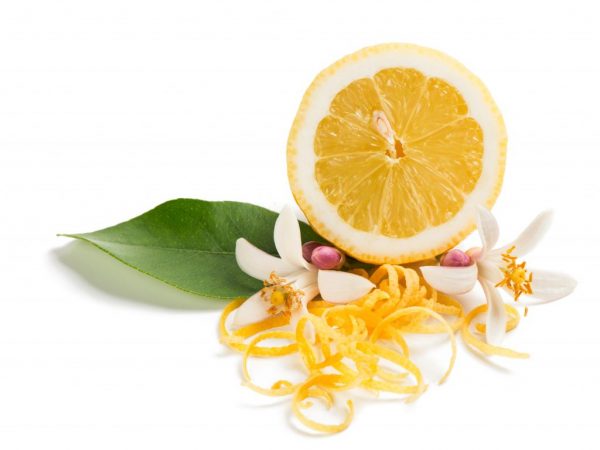Characteristics of lemon zest
The peel and seeds of citrus fruits contain a large amount of nutrients. Lemon peel is a common flavoring and main ingredient in many medicines.

Characteristics of lemon zest
Characteristics of lemon zest
Lemon zest is the thin top layer of the fruit's rind. It contains the maximum amount of essential oils and vitamins for the fetus.
The lemon peel tastes sour-tart, without bitterness. The aroma is pronounced, due to which the product is used in perfumery and cosmetology.
Composition and calorie content of the supplement
The energy value of the product is 48 kcal per 100 g. The zest contains:
- fats - 0.35 g;
- proteins - 1.4 g;
- carbohydrates - 5.4 g.
100 g of the additive accounts for 80 ml of water and 0.56 g of ash. Lemon zest contains a large amount of vitamins:
- vitamin E - 0.25 mg;
- vitamin C - 1.29 mg;
- vitamin A - 3 mg;
- B vitamins (B1, B2, B5, B6) - 6.7 mg.
Lemon peel contains such macronutrients as phosphorus, potassium, sodium and magnesium. The product also contains iron, zinc and copper. The amount of sucrose per 100 g of product is 4.6 g.
Beneficial features
The benefits of lemon peel are components that prevent the development of many diseases. The product is used to prevent such diseases:
- osteoporosis;
- liver intoxication;
- bloating, gastritis and colitis;
- high blood pressure;
- heart failure;
- muscle cramps.
Lemon peel also accelerates the regeneration of the epidermis and normalizes the sebaceous glands. The supplement boosts immunity and relieves airway inflammation. The product also helps to quickly heal the thyroid gland and restore hormonal balance in the body.
The product is used to relieve psychological disorders. Also, lemon peel is used in dentistry to whiten enamel and reduce bleeding gums.
The most important property of the product is considered to be its anti-cancer effect on the body. The mineral components of the zest destroy cancerous swellings and slow down the development of metastases. The product is used in the treatment of cancer of the prostate, rectum and stomach. The supplement also reduces the risk of cancer in women.
Contraindications to use

Peel can make stomach problems worse
The harm of lemon peel is manifested in the concentrated content of acid and trace elements that can cause damage to the human body. Lemon zest is not recommended for such diseases:
- Allergy to citrus fruits. The product increases the amount of histamine, which leads to swelling of the airways.
- Pharyngitis, acidity, ulcers and stomatitis. Lemon peel irritates the mucous membranes, which aggravates the disease.
- Heartburn. The supplement increases the amount of enzymes that harm the intestines.
Doctors advise against adding the product to baby food. The concentrated supplement may cause indigestion and allergic reactions in a child.
Zest preparation methods
Only fresh fruit is used for cooking. Lemon that looks lethargic is not suitable for cleansing. Cut fruits are also not suitable: the pulp of such lemons has already released the juice, and some of the beneficial enzymes have been lost.
An important stage in the preparation of the product is the preparation of the fruit. Manufacturers often wax citrus fruits for better keeping quality. The fruits are washed under running water and cleaned with a brush. After that, the lemons are poured over with boiling water and left to lie at room temperature for an hour.
Before removing the peel, cut off the top of the fruit.
There are several ways to peel a lemon. The choice of method depends on the further use of the product:
- Vegetable peeling knife. This tool is used to peel thick-skinned lemons. When peeling thin-peeled fruits, there is a risk of touching the bitter white layer. The zest, which has been peeled off with a vegetable peeler, is used for medicinal tinctures and cosmetics.
- Thin knife. With its help it is easy to get a thin layer of rind Due to its irregular shapes, such an additive is used in cooking for the preparation of drinks and jams.
- Fine grater. This method can be used to make the highest quality lemon zest, since only the first layer of the lemon peel is removed. The neat shape allows the additive to be used for cooking and decorative purposes.
For decoration, a product peeled with sester is also used. This special citrus knife allows you to cut the peels of lemons with a thin serpentine.
Regardless of the cooking method, it is important to remove only the top of the peel. The white layer will not harm the human body, but it will make the additive taste bitter.
Storing the zest
To make the product last longer, it is processed in several ways. The most popular are:
- Drying. Grated zest on a fine grater is spread on a sheet of paper and dried on a sunny windowsill during the day. After the procedure, the supplement is stored in paper bags or glass jars.
- Freeze the product. The finished supplement is stored in a freezer at a temperature of -3 ° C. If the zest is used for medical purposes, alcohol is added to the container with the product (40 ml of vodka per 100 g of the additive). In this form, the additive is capable of retaining beneficial properties. It is better to freeze the product grated on a coarse grater.
- Conservation. The product is sprinkled with sugar in a 1 to 1 ratio and canned. In this form, lemon peel retains its beneficial properties for the longest time.
Dried lemon peels are often ground to a powder and stored in tin containers. In this form, the product can be conveniently added to baked goods.
Applying lemon zest

Zest is added to sauces and syrups
The product is used in cooking as an aromatic additive. On the basis of grated lemon zest, lemonades and jam are prepared. Also, the additive is widely used in the preparation of sweet and sour sauces for meat and fish.
In cosmetology, dry lemon peel is used to treat oily skin and acne. The product forms the basis of anti-cellulite creams that are easy to prepare at home. The supplement is beneficial when combined with other citrus fruits such as grapefruit extract or orange seeds.
Traditional medicine uses zest for acute colds. Alcohol compresses with the addition of the product help with joint pain. Compresses are also used to stretch the ligaments. Due to its high pectin content, lemon zest is used during diets. The supplement neutralizes hunger.
Lemon zest is widely used in everyday life. It is used for different purposes:
- Water infused on the product for a week can replace the detergent. It effectively removes greasy stains from all surfaces.
- The product removes unpleasant odors in the refrigerator and freezer.
- Lemon essential oil has a negative effect on harmful insects. If cockroaches are in the house, you should pour fresh zest near the threshold and in all corners of the apartment.
- Fresh zest helps to remove lime from nickel-plated surfaces.
Using a dry additive during dishwashing helps to remove old stains from the cups. Lemon peel is used to clean the microwave oven. To do this, 100 g of grated fresh lemon zest is mixed with 200 ml of water and placed in the microwave for 5 minutes. After that, the oven is wiped with a regular sponge.
Conclusion
The benefits of lemon peel are more vitamins. The product is used in everyday life, cooking and medicine. The preparation and storage of the zest depends on the further use of the product. The supplement is not recommended for people with gastrointestinal problems and individual intolerance.


